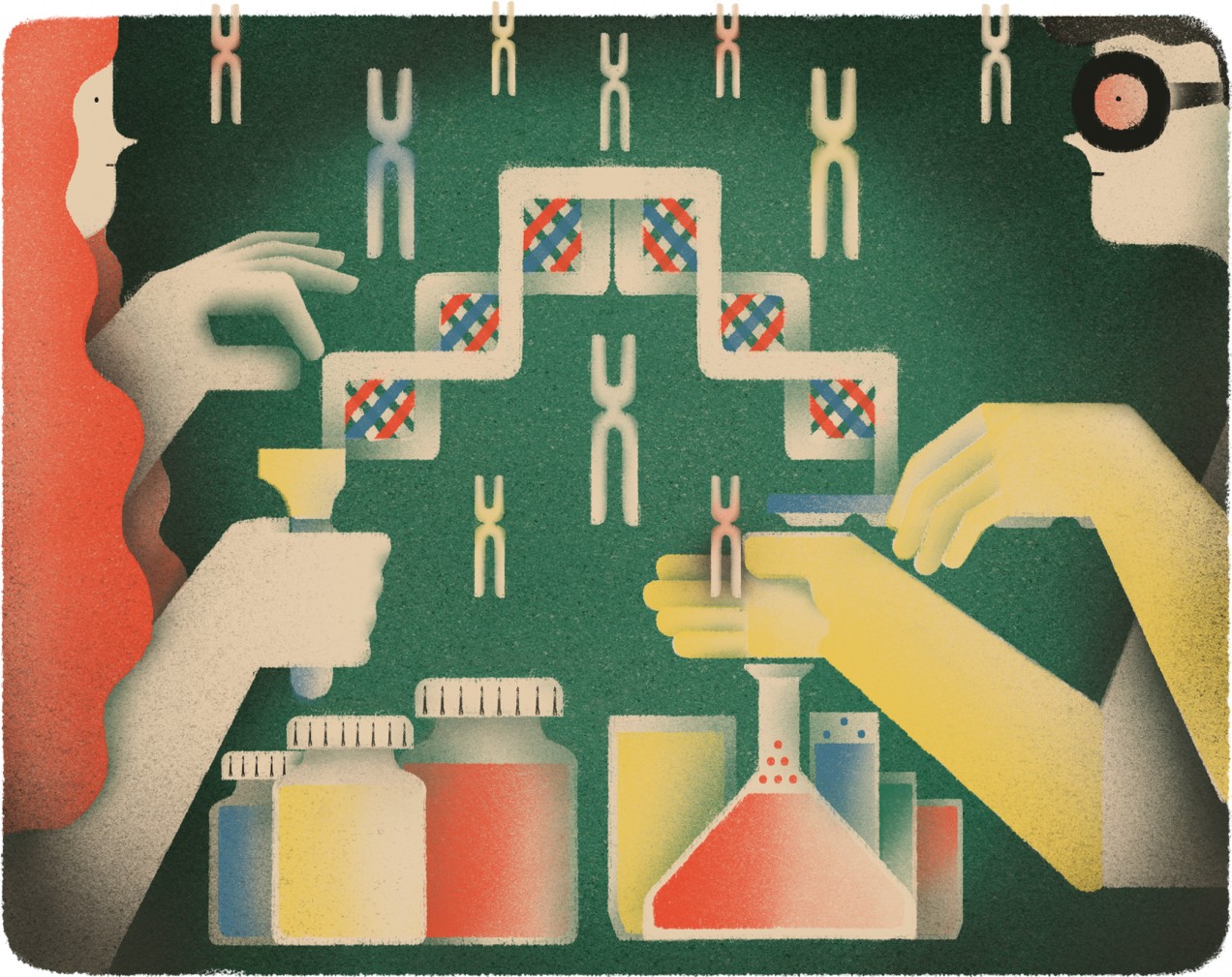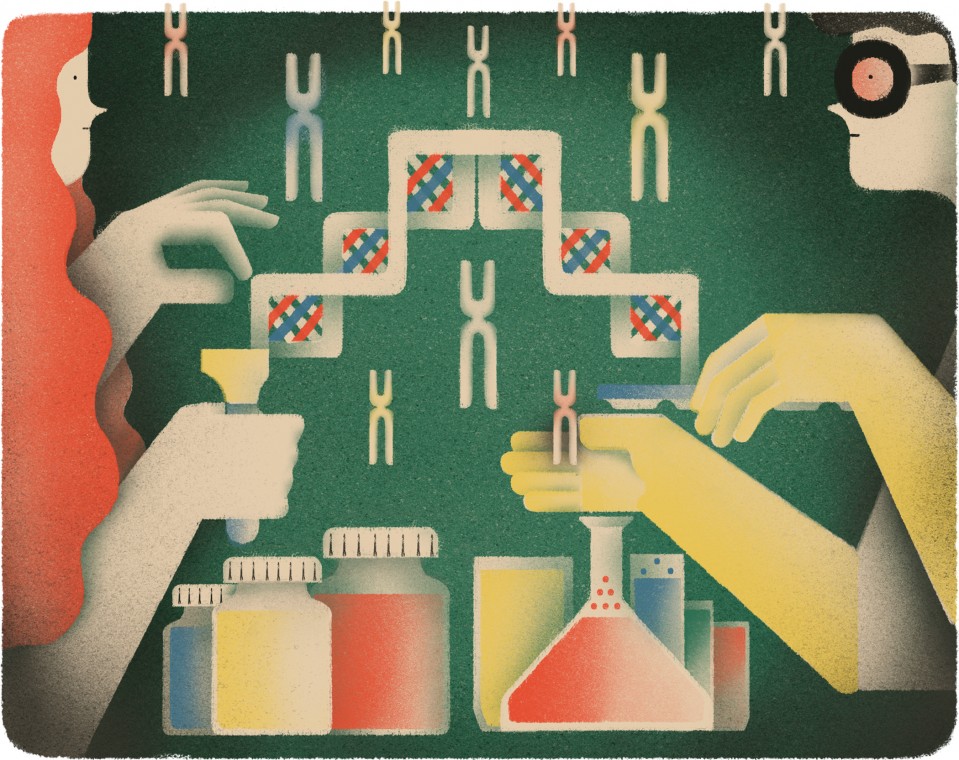

Rewriting Life
Why We Have a Right to Consumer Genetics
It’s hard to get straightforward health guidance from personal genome tests, which are banned in some places. But one way to make them more meaningful is to let more people buy them.

It was easy to send my spit to 23andMe, a personal genetics company based in Mountain View, California. I filled the tube that came by mail with a few milliliters of saliva, mixed in the preservative solution, and screwed on the cap, and my sample was ready to be mailed. Soon I would know my risks for Alzheimer’s, breast cancer, and obesity, and I’d have an idea what medications I should avoid.
Well, not exactly. As in most of human genetics, what’s tricky about consumer-friendly tests is interpreting the significance of DNA variation. A couple of weeks after shipping off my tube, I got an e-mail notice that my results were on 23andMe’s website. While it was fun to click through my ancestry reports, I was less compelled by the analysis of the genetic traits that could influence my health.
The biggest disease risk in my report? I have a 5.2 percent chance of developing restless leg syndrome later in life—24 percent greater than the average person, who has a 4.2 percent risk. My risk for Alzheimer’s is slightly lower than average and my risk for obesity is typical. But these conclusions are not particularly meaningful. New studies could uncover variants in my genome that carry a significant risk for dementia later in life. And for obesity, genetics can be overshadowed by lifestyle.
The results did contain some useful information, however. For example, my genome carries signs that I have an above-average sensitivity to a common blood thinner. Currently, I don’t need such a drug, but if that changes—say, if I suffer a heart attack—then this knowledge could be critical in helping a physician determine the proper dose of a potentially life-saving medication. I also found motivation to switch to decaffeinated coffee—my report says I am a slow caffeine metabolizer, which is associated with a risk of heart attacks for multi-cup-a-day users like me.
In some ways, I was lucky that I found nothing monumental in my report. “About 40 to 50 percent of customers end up with results like yours—they don’t have anything that jumps out very strongly,” says Joanna Mountain, senior director of research at 23andMe. But for many, the results are potentially more significant. “For example, for macular degeneration, the risks [that are indicated in the reports] range from 0.1 percent up to 74 percent,” Mountain says. “For heart disease, there’s a big range—10 to 50 percent.”
It can be difficult for most people to understand what these ranges mean, though. And for now, it’s not clear how receptive the medical community is to helping. “I’ve had patients bring me these reports, and I don’t spend a lot of time reviewing the results because this is not a test I would have ordered,” says Sharon Plon, a geneticist and physician-scientist at Baylor College of Medicine in Houston. What’s missing is proof that these tests can inform and improve patient care, she says: “Physicians are going to shy away from using them unless they become part of evidence-based medicine.”
Typically, personal genetics companies like 23andMe determine which particular DNA base pairs each customer has at places in the human genome that are known to vary from person to person. The companies then interpret the results of scientific studies to tell customers what their results mean. The tests are sold directly to consumers for as little as a few hundred dollars, without the involvement of a health-care provider. In 2010, the FDA sent letters to several companies warning them that their products were considered medical devices subject to regulation, although exactly how the oversight would happen still hasn’t been firmly established. That same year, the Government Accountability Office sent samples to four companies and got conflicting results.
Because interpreting the results is so uncertain and the relationship between genetics and disease risk is sometimes weak in the first place, some critics oppose selling these tests directly to consumers. Such sales are restricted in some countries, such as France, and in a few U.S. states, including New York and Maryland. The American College of Medical Genetics and Genomics’ stance is that the tests should be taken with guidance from an expert who can assess the validity of the results and explain the actions that could be taken in response, says executive director Michael Watson. New studies on the connection between DNA and disease or drug response are published every week. Some of these studies establish a previously unknown link; others may add more weight to a known association; yet others may contradict or disprove what was once thought to be meaningful. “The results of many of these tests are very complex,” says Plon.
Yet this “father knows best” attitude is irksome to many; surely people have a right to such data about themselves, regardless of the complexity and ambiguity of the results. “To tell somebody you don’t have the right to access information about your own biology, for any reason, is pure paternalism,” says Misha Angrist, an assistant professor at the Duke University Institute for Genome Sciences & Policy. Moreover, most family doctors, and even many specialists, are unfamiliar with genetic tests, and those who’ve been out of medical school for several years may have no training in genomics at all. In many cases, the consumer might well be better informed.
“I don’t think we give enough respect to consumers,” says Eric Topol, who is director of the Scripps Translational Science Institute. Topol is troubled by efforts to prevent the tests from being sold to consumers, arguing that patients could be the best advocates for bringing genomics into medicine. “We should be in an era of democratizing DNA,” he says. “I think that if we block the consumer from direct access, that’s really unfortunate, because they are ultimately going to drive this story. If we keep it open to consumers … eventually, that will force the doctors to get up to speed.”
In 2011, the New England Journal of Medicine published a survey that Topol and colleagues conducted with more than 2,000 customers of the genetics company Navigenics. It asked them how well they understood the information that Navigenics gave them and whether they exhibited signs of psychological trauma in response to being told potentially ominous things about what their medical future might hold. “Turns out people assimilate this information very well, and there is no evidence of psychological disturbance,” Topol says. “People really grasp this information.”
For now, the biggest problem with consumer-friendly genetic products is simply that they may be medically inconclusive for most people. Indeed, I was more interested in the result that my genome was 2.7 percent Neanderthal (a tad higher than the 2.6 percent average for people of northern European descent). But as the costs of medical care continue to skyrocket and many individuals look for more opportunities to control their own health, these tests—if they become more powerful—could become an essential tool for understanding our bodies and helping guide us to behaviors and choices that will lead to better outcomes.
What will keep me returning to this technology will be the updates sure to come from the scientific community as researchers continue to decipher the medical meaning of the human genome. Of the million DNA variants that 23andMe examines, fewer than 1,000 are part of the health report. The rest wait for evidence linking them to traits. In some ways the story of consumer genetics parallels that of human genomics as a whole: the challenge ahead is to figure out what specific genetic variations signify and then study them in a health context to see whether they make a real difference to patients and doctors. It would be a shame to restrict personal genetic tests now, before they have a chance to become more useful. Rather, consumers should be allowed to explore their genetic makeup to help figure out how the information can be used to make smarter medical decisions.
Advertisement